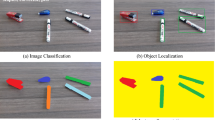Abstract
Image segmentation is one of many fundamental problems in computer vision. The need to divide an image to a number of classes is often a part of a system that uses image processing methods. Therefore, lots of methods were developed that are based on different approaches. The image segmentation could be classified with respect to many criteria. One such a criterion is based on the degree of allowed interactivity. The interactivity could be of several types—interactive initialization, interaction while the computation is running or manual refinement of achieved results, for example. Especially the precise initialization plays an important role in many methods. Therefore the possibility to initialize the method manually is often invaluable advantage and information obtained this way could be the difference between good and poor results. Unfortunately, in many cases it is not possible to initialize a method manually and the process needs to be automated. In this paper, an approach for such an automation is presented. It is based on shortest paths in a graph and deriving an area of influence for each obtained seed point. This method is called shortest path basins.
Similar content being viewed by others
References
Y. Li, J. Sun, C.-K. Tang, and H.-Y. Shum, “Lazy snapping,” ACM Trans. Graph. 23 3, 303–308 (2004).
J. C. Bezdek, Pattern Recognition with Fuzzy Objective Function Algorithms (Kluwer Acad. Publ., Norwell, MA, 1981).
P. F. Felzenszwalb and D. P. Huttenlocher, “Efficient graph-based image segmentation,” Int. J. Comput. Vision 59 2, 167–181 (2004).
J. Shi and J. Malik, “Normalized cuts and image segmentation,” IEEE Trans. Pattern Anal. Mach. Intellig. 22 8, 888–905 (2000).
T. Ryba, M. Jirik, and M. Zelezny, “An automatic liver segmentation algorithm based on grow cut and level sets,” Pattern Recogn. Image Anal. 23 4, 502–507 (2013).
V. Vezhnevets and V. Konouchine, “Growcut–interactive multi-label n-d image segmentation by cellular automata,” in Proc. GraphiCon’2005 (Novosibirsk, 2005), pp. 150–156.
Y. Boykov, O. Veksler, and R. Zabih, “Fast approximate energy minimization via graph cuts,” IEEE Trans. Pattern Anal. Mach. Intell. 23 11, 1222–1239 (2001).
L. Grady, “Random walks for image segmentation,” IEEE Trans. Pattern Anal. Mach. Intellig. 28 11, 1768–1783 (2006).
A. Blake, C. Rother, M. Brown, P. Perez, and P. Torr, “Interactive image segmentation using an adaptive gmmrf model,” in Proc. ECCV (Prague, 2004), pp. 428–441.
V. Pathak, P. Dhyani, and P. Mahanti, “Autonomous image segmentation using density-adaptive dendritic cell algorithm,” Int. J. Image, Graph. Signal Processing 5 10, 26–35 (2013).
M. Wertheimer, Laws of Organization in Perceptual Forms (Harcourt, Brace & Jovanovitch, London, 1938).
T. Pavlidis, “A critical survey of image analysis methods,” in Proc. ICPR (Paris, 1986), pp. 502–511.
C. K. Chow, “A recognition method using neighbor dependence,” IRE Trans. Electron. Comput. EC-11 5, 683–690 (1962).
A. Blake, P. Kohli, and C. Rother, Markov Random Fields for Vision and Image Processing (MIT Press, 2011).
J. M. Hammersley and P. E. Clifford, Markov Random Fields on Finite Graphs and Lattices (1971).
S. Kakutani, “Markov processes and the dirichlet problem,” Proc. Jpn. Acad. 21, 227–233 (1945).
P. G. Doyle and J. L. Snell, “Random walks and electric networks,” Am. Math. Monthly 94, 202 (2000).
R. Courant and D. Hilbert, Methods of Mathematical Physics Volume II. (John Wiley & Sons (1966), Vol. 2.
R. Hersh and R. J. Griego, “Brownian motion and potential theory,” Sci. Amer. 220, 66–74 (1969).
T. Ryba, M. Jirik, and M. Zelezny, “An automatic image segmentation algorithm involving shortest path basins,” Pattern Recogn. Image Anal. 25 1, 89–95 (2015).
Y. Boykov and G. Funka-Lea, “Graph cuts and efficient n-d image segmentation,” Int. J. Comput. Vision 70 2, 109–131 (2006).
R. Unnikrishnan and M. Hebert, “Measures of similarity,” in Proc. 7th IEEE Workshops Application of Computer Vision WACV/MOTIONS’05 (Breckenridge, CO, 2005), Vol. 1, p. 394.
D. Martin, C. Fowlkes, D. Tal, and J. Malik, “A database of human segmented natural images and its application to evaluating segmentation algorithms and measuring ecological statistics,” in Proc. 8th Int. Conf. on Computer Vision (Vancouver, July 2001), Vol. 2, pp. 416–423.
Author information
Authors and Affiliations
Corresponding author
Additional information
The article is published in the original.
This paper uses the materials of the report submitted at the 9th Open German-Russian Workshop on Pattern Recognition and Image Understanding, held on Koblenz, December 1–5, 2014 (OGRW-9-2014).
Tomas Ryba was born in 1985 in Plzen, Czech Republic. He received his M.S. degree in Cybernetics from the University of West Bohemia (UWB), Plzen, Czech Republic in 2009. As a Ph.D. candidate at the Department of Cybernetics, UWB, his research interests focus on medical imaging and image segmentation. He is also a teaching assistant at UWB.
Milos Zelezny was born in Plzen, Czech Republic, in 1971. He received his M.S. and Ph.D. degrees in Cybernetics from the University of West Bohemia, Plzen, Czech Republic (UWB) in 1994 and in 2002 respectively. Since 2012 he is an associate professor at the UWB. He has been delivering lectures on Digital Image Processing, Structural Pattern Recognition and Remote Sensing since 1996. He is working in projects on multi modal humen-computer speech interfaces and computer vision.
Rights and permissions
About this article
Cite this article
Ryba, T., Zelezny, M. An automatic initialization of interactive segmentation methods using shortest path basins. Pattern Recognit. Image Anal. 26, 336–342 (2016). https://doi.org/10.1134/S1054661816020188
Received:
Published:
Issue Date:
DOI: https://doi.org/10.1134/S1054661816020188




